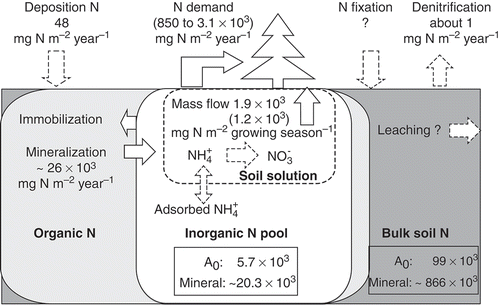Figures & data
Table 1 Observed and estimated total inorganic nitrogen (N) in throughfall and deposition
Table 2 Soil nitrogen (N) pools in the organic layer and mineral soil layer 0 to 50 cm: average with standard deviation (SD) and repeated number of samples (in parentheses) for bulk N, potassium chloride (KCl)-extractable and water-extractable ammonium (g N m−2), nitrate and total free amino acid (mg N m−2).
Table 3 Soil inorganic nitrogen (N) pools before and after incubation experiments and calculated production calculated for the mineral soil layer 0–50 cm for the period of incubation (g N m−2)
Figure 1 The change in larch (Larix cajanderi Mayr.) needle δ15N observed during amino acid and ammonium tracer experiments held from 30 June to 2 July (a, c, and e) and from 27 to 29 July 2009 (b, d, and f), calculated from needle δ15N of each sample tree before the tracer application, ranged from −5.2 to 0.2‰. Different markers (open or closed square, triangle, or circle) indicate each sample tree. A broken line indicates the average δ15N change (e and f). Although the same markers were used to indicate individual trees in two experiments, the trees are not the same.

Figure 2 The relationship between inorganic nitrogen (N) soil pool and soil temperature cumulative degree day. Open squares indicate potassium chloride (KCl)-extractable inorganic N pool (mineral soil layer 0–50 cm) observed from 2009 to 2011 (data shown in ). A fitted line was also shown. Degree days were calculated for each observation date from the soil temperatures above 0°C observed at 20 cm from 2009 to 2011.

Figure 3 The seasonal changes in the size of the soil inorganic nitrogen (N) pool observed in 2009 (a), 2010 (b), and 2011 (c). A solid line represents daily average soil temperature observed at 20 cm depth, open squares denote potassium chloride (KCL)-extractable soil inorganic N pool size. “Layer” indicates the soil mineral layer, 0–50 cm.

Figure 4 The schematic figure for nitrogen (N) pools in the soil (mg N m−2) and ecosystem fluxes. Areas outlined with solid lines represent the following: dark grey, bulk soil N pool; light grey, organic N pool, white, potassium chloride (KCL)-extractable inorganic N pool. Areas outlined with dashed lines represent the water-extractable part of the inorganic N pool in the soil solution. The maximum sizes of the pools are described in the figure as outlined values. “A0 ” and “Mineral” denote pools in organic layer and mineral soil layer (0–50 cm). respectively. Fluxes within the ecosystem or larch (Larix cajanderi Mayr.) trees (in parentheses) are shown by arrows with open values. Solid arrows are major fluxes, whereas dashed arrows are those expected to be minor or negligible. The maximum net mineralization rate () shown here was calculated from the incubation that covered almost one year. N demand and mass flow estimation were explained in sections 4.2 and 4.3, respectively. “Growing season” indicates the period from 1 June to 31 August. The value for denitrification was calculated from Koide et al. (Citation2010). Values of N fixation and leaching are not indicated here but are expected to be minor (Shugalei and Vedrova Citation2004).
